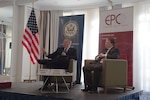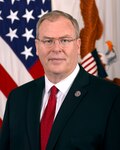Work: U.S., NATO Must Use 21st-Century Approaches for Deterrence, Dominance
U.S. Department of Defense sent this bulletin at 04/29/2016 07:12 PM EDTYou are subscribed to no topic for U.S. Department of Defense. This information has recently been updated, and is now available.
Work: U.S., NATO Must Use 21st-Century Approaches for Deterrence, DominanceBy Cheryl Pellerin DoD News, Defense Media Activity BRUSSELS, April 29, 2016 — The strategic landscape is at an inflection point that demands the United States and NATO use 21st century approaches to address threats large and small and to strengthen conventional deterrence against potential adversaries, Defense Secretary Bob Work said here yesterday. During a speech here at the European Policy Center, an independent nonprofit think tank, Work discussed the Defense Department’s third offset strategy and related plans for retaining military advantage over great-power competitors such as Russia. His visit was part of a weeklong trip to discuss with military and government officials in Sweden and Belgium topics such as regional security, accelerating the fight against the Islamic State of Iraq and the Levant, and working with NATO to plan for a fast-moving future. “We believe very strongly that we're at an inflection point in the strategic landscape ... and as part of that strategic landscape, Europe -- and by extension NATO -- is facing threats from the south, from the east, from the north and from within,” Work said. Each challenge is different, he added, but each must be addressed with vigor, determination and most importantly collaboration across the Atlantic and within the NATO alliance and the European Union. Fighting Global Terrorism Beginning with global terrorism, Work praised the contributions of European countries, NATO and Gulf partners in the fight against ISIL. The United Kingdom is contributing significantly to the air campaign and to the advise, train and assist mission, he said. Italy has provided key enablers and is helping defend against ISIL's shift to Libya. The French continue to battle ISIL and other terrorist groups across the Sahel in Central Africa, and in Iraq and Syria. And European nations, including Germany, the Netherlands, Belgium, Spain and many others, are contributing to the accelerated fight, Work added. “We have to do more and we're asking NATO to consider doing more, especially in the area of training Iraqi security forces in three primary areas -- police, logistics and border security. So, in addition to the bilateral agreements we have with our allies, we're asking NATO to step up also,” the deputy secretary added. Disrupt, Dismantle, Destroy “The lasting defeat of [ISIL] and other extremist groups is a global undertaking,” he noted, “because they're a global threat.” Work added, “We're not recommending that NATO get involved in the internal security of countries on the continent. We're asking all governments to act to disrupt, dismantle and destroy extremist capabilities, recruiting and finances within their own borders.” Broadly, he said, that means improving the ability to gather intelligence, share intelligence among all nations, improve counterterrorism cooperation and partnerships, and enhance training of security forces. “The United States stands ready to help whenever asked,” the deputy secretary said. Resurgent Russia The other main challenge to NATO is a resurgent Russia, Work added, a situation the United States is helping address with a request to Congress for $3.4 million to fund the European Reassurance Initiative. The initiative’s next step is to establish a heel-to-toe military rotation on the continent. “Every time a brigade moves out, another brigade will come in,” he explained. “That means an armored brigade combat team will be on European territory 24 hours a day, seven days a week, 365 days a year.” By the end of September 2017, he said, “we will have a full division of U.S. troops in Europe all the time, with an airborne brigade in Italy, a Stryker brigade in Germany, and an armored brigade that rotates in constantly and that is backed up by a prepositioned set of [military] equipment for another armored brigade combat team.” The department is taking these steps to strengthen deterrence,” Work said. “That's what this is all about.” NATO must think anew about such concepts, he added, because responding effectively to Russian aggression and confrontation requires the exercising of strategic muscles for the first time in decades. Third Offset Strategy “That's why we’re exploring the third offset strategy,” Work said. “It is a combination of technology, operational concepts and organizational constructs -- different ways of organizing our forces -- to maintain our ability to project combat power into any area, at a time and place of our own choosing.” The third offset, he added, is about preserving peace, not fighting wars. Today -- unlike the environment in which the first offset in the 1950s-1960s and the second offset in 1970s-1980s took place, the deputy secretary explained, competitors have access to many of the same commercially developed technologies that the department relies on, and they can quickly mimic state-of-the-art DoD systems with globally sourced components.
Work said the “technological sauce” of the first offset was miniaturization of nuclear components. In the second offset, he added, that “sauce” included digital microprocessors, information technologies, new sensors and stealth.
“We believe quite strongly that the technological sauce of the third offset is going to be advances in artificial intelligence and autonomy,” which will allow the department to create collaborative human-machine battle networks, he said. Battle networks consist of three interconnected grids, Work explained -- a sensor grid; a command, control, communications and intelligence grid; and an effects grid. Artificial Intelligence and Autonomy “AI and autonomy put inside these battle networks is going to allow collaborative human-machine operations to absolutely new levels, letting the machines do what they do best and humans do what they do best in what we call human-machine symbiosis,” the deputy secretary added. The capabilities are being driven by revolutions in artificial intelligence, computer processing power, deep-learning machines and autonomous control systems, he said. “DoD is going to leverage AI technology, particularly in things like cyber defense, electronic warfare defense and missile defense. But it’s also clear to us that we need to go to new levels of human-machine symbiosis,” Work added. “These technologies are going to happen because they’re happening in the commercial realm and they’re going to affect all of our lives,” the deputy secretary said. “We will inevitably use them no matter what happens to our competitors, and they will allow us to be more efficient [and] make us less likely to have casualties because we’ll be able to use unmanned systems in many different ways that take men and women out of danger.” He added, “We’re in a competition where people use commercial technologies, and we have to stay ahead of them.” Conceptual Reawakening Work said it’s time for a NATO conceptual reawakening, and that the alliance must examine how it can deploy and sustain highly agile lethal formations in the face of conventional guided munitions, unmanned aerial vehicles, cyber and electronic warfare. “We think, for example, that NATO might consider standing up a new operational fires force … that would allow any soldier operating anywhere in NATO to call in fires,” he added. “We think this would be an incredibly important way to improve deterrence because it is inherently defensive and would also, hopefully, convince any Russian military planner that they would not be able to succeed.” As the United States increases its focus and investments on conventional deterrence, the deputy secretary said he hopes NATO allies will start to do the same. The United States also urges all NATO members to remain on the current upward trajectory of modernizing their forces and reversing recent declines in defense spending, Work added. “In our defense budgets, our planning, our capabilities and our actions,” he said, “we have to demonstrate to any strategic competitor that if they start a war, we have the capability to win it on our terms. And that’s the best way to underline and strengthen conventional deterrence.” (Follow Cheryl Pellerin on Twitter: @PellerinDoDNews) |
||
Related Biographies
|


